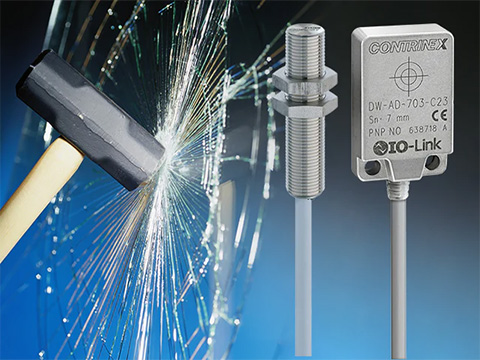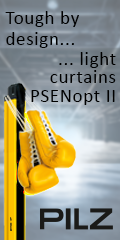
Posted to News on 20th Jun 2025, 12:30
A star from my demo kit toolbox of sensors
In a recent conversation with a system integrator, PLUS Automation managing director Mark Weymouth got to discussing the special or best sensors in his 'tool kit'. That conversation inspired him to pick a sensor and explain why this robust, unusually shaped, IP69K-rated inductive sensor from Contrinex is especially useful across a wide variety of industries and applications.

(See PLUS Automation at FoodManufacturing.Live, 15 October 2025, on stand 48)
Contrinex is perhaps best known for its uniquely robust 'Extreme' or '700-Series' family of inductive sensors. Whereas normal inductive sensors are fragile, these sensors can survive impacts and abrasions, for example, surviving being bashed by the tool-setter's spanner. This extraordinary robustness is demonstrated by using a sensor to hammer nails into a piece of wood.
The inductive sensor's front face and housing are machined from a single piece of stainless steel. The thick front face provides extraordinary abrasion resistance and unmatched abilities to resist shock and impact damage. The sensors are also resistant to vibration and rated to IP68/ IP69K to resist dust and fluids such as oil and cleaning solvents.
Considerable cost savings are achieved by businesses which switch from using traditional inductive sensors, which are often treated as a frequently replaced consumable product, to Contrinex '700' Series sensors. For less than twice the cost of standard sensors, these almost indestructible inductive sensors not only provide a savings from not needing to buy replacement sensors, but they also offer substantial labour savings from not having to swap sensors, let alone lost production.
The 'Extreme' '700 Series' inductive sensors have a detection range that is three times the norm, and they can equally detect both ferrous and non-ferrous materials.
The '700 Series' inductive sensors are available in sizes ranging from M4 to M30, but a favourite, or perhaps the 'special' one in the family, is the flat or cubic 'C23' sensor. This inductive sensor measures 20 x 30 mm in width and is only 8 mm thick. It provides a long 7mm sensing range, from the target shown on its front face. For comparison, an M12 cylindrical '700 Series' inductive sensor has a 6 mm sensing distance and a body length of 50 mm behind the sensing face.
The embeddable sensor can be flush-mounted or recessed into a metal surface, and its resistance to abrasion or impact damage makes it great for use in assembly jigs and tables. The sensor's long sensing range also reduces the potential for mechanical damage in automation equipment.
Contrinex offers an option for an enhanced corrosion-resistant V4A/AISI 316L stainless steel housing for the 700-Series of inductive sensors, and it is this higher-grade material that is used for the housing on the C23 cubic sensors.
Rotary indexing table
An example application for the slim cubic inductive sensor is on a rotary indexing table. The indexing table is quicker at transferring an assembly between three robots, each of which performs an activity, as well as taking the assembly on and off conveyors. The rotary indexing table also reduces the need for robots to transfer the assembly between stations.
Conveyors deliver a continuous stream of parts to the rotary indexing table, which transports them in sequence to each assembly robot. As the table rotates, a sensor verifies the alignment of the table, bringing it to a halt, so that the parts are correctly positioned. It also initiates the first robot to pick and place the assembly from the conveyor, and the other robots to perform their functions.
At each assembly station, automated pick-and-place equipment adds components to the assembly. Dedicated transport mechanisms - including vacuum lifters, electromagnetic clamps and mechanical grippers - insert items swiftly and accurately in their designated positions. Inductive sensors also play a key role in confirming the secure closure of custom-designed robot grippers.
On completion of the final assembly stage, the finished assembly is placed onto a linear conveyor system, where inductive sensors mounted under the conveyor detect the assembly as it passes. This sensor not only confirms the presence of the assembled item, but also measures throughput by incrementing a count in the control PLC system.
Fast, precise and reliable detection is required for the system to operate continuously at high speed. This is made easy by the Contrinex C23 inductive sensor, which features a switching frequency of 180 Hz. The 7mm sensing distance provides ample operating clearance, minimising the risk of mechanical collision with other elements of the table. Their implementation into the assembly equipment is made easier by the choice of PNP or NPN outputs with either a PUR cable or an M8 pigtail connector.
Designed for demanding applications, Contrinex's rugged C23 inductive sensors offer exceptional robustness, impact and abrasion resistance, making them a versatile, cost-effective and highly reliable solution.
Contrinex sensors are trusted across a wide array of challenging applications, and their wide choice of sensors, often with unique technologies, provides robust and reliable sensing solutions.
Want the latest machine building news straight to your inbox? Become a MachineBuilding member for free today >>















